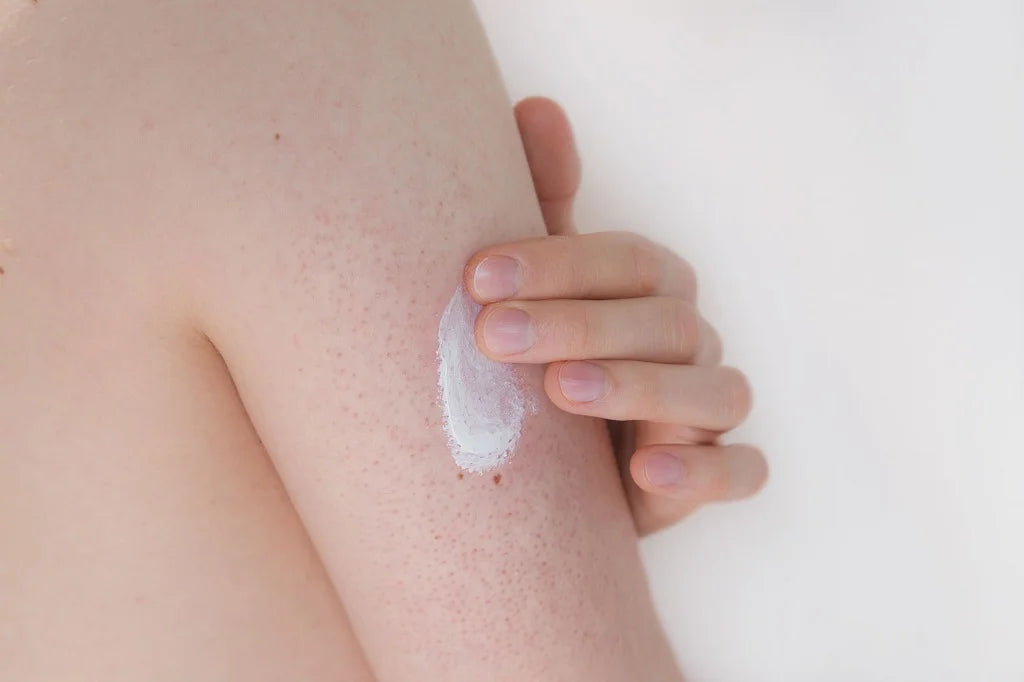
Keratosis Pilaris: Symptoms, Causes & Treatment

Dr. Shireen Singh, MBBS.
Written by Our Editorial Team
Ever heard of a skin condition that causes small bumps on your body? If you are someone who has fallen victim to the so-called ‘chicken skin’ do not panic, we have got you covered. This condition is called Keratosis Pilaris often referred to as 'KP' or 'Chicken Skin'.
A condition in which unattractive bumps appear on the arms, back, and thighs. These bumps can lead to self-consciousness and insecurity in many individuals. So here's an insight on how to manage KP and seek confidence in your own skin.
Also Read : Chicken Skin: Symptoms, Causes & Treatment
Getting To Know Keratosis Pilaris
It is a harmless skin condition in which small bumps appear on the upper arms, back, thighs, cheeks, buttocks and the parts that have hair follicles.They may also appear on the face but that's not very common. These bumps are not painful but may cause itching and may appear red, brown, white or sometimes the same colour as your skin.
This skin condition is common in babies, toddlers, children, teenagers and may worsen during puberty. The chances of you getting this skin condition also depends on genes, or if you have Asthma, Eczema, Obesity etc.
Keratosis Pilaris Symptoms

Source : Shutterstock
Let's talk about Keratosis Pilaris Symptoms, so if you happen to experience any of these, you might have it.
- Painless tiny bumps on upper arms, thighs, back, butt and body parts with hair follicles.
- The symptoms become worse when the season changes, especially during the winter season.
- The areas with bumps will be rough and dry.
- There will be itchiness and irritation in the affected area.
But you need to keep in mind that there are many skin conditions that might have the same symptoms. So it's better to reach out to a medical professional.
Keratosis Pilaris Causes

Source : Shutterstock
Now the question is what are the causes of KP skin? To understand better let's see what Keratosis Pilaris actually means. The term 'Keratosis' means that there is too much Keratin, a protein that protects the skin from any infection and 'Pilaris' originates from the Latin word for hair (Pilus).
The exact Keratosis Pilaris causes are not known but it is believed to be related to these factors.
- This skin condition occurs when too much Keratin blocks the opening of the hair follicles, resulting in rough patches, and bumpy skin.
- People with certain skin conditions like Atopic Dermatitis and those with dry skin are more likely to experience it.
- KP may sometimes become worse when there are hormonal changes such as puberty, pregnancy etc
- If KP runs in the family then you are most likely to inherit it.
- KP often worsens during seasonal changes, especially during winters
Also Read : What Does It Mean To Have Dry, Bumpy Skin? Find Out If It's Keratosis Pilaris!
Keratosis Pilaris Treatment

Source : Shutterstock
We are sure you all must have desperately searched for ways to get rid of Keratosis Pilaris but sadly, it is not possible. KP is not completely curable but treatable. All you need is patience and the right Keratosis Pilaris treatment. With the right KP treatment you can improve the appearance of the skin and reduce the symptoms.
Some ways to treat Keratosis Pilaris:
- Use creams and lotions that contain alpha hydroxy acids, lactic acid, or urea which helps in softening the skin.
- Regularly use moisturiser to keep the skin hydrated.
- Avoid wearing tight clothes.
- Laser therapy reduces the redness and improves skin texture.
- Microdermabrasion is an intense exfoliating treatment that improves the texture and appearance of skin.
- Many exfoliating scrubs are available in the market to remove the dead skin of KP. We recommend ThriveCo's Bumps Eraser Exfoliating Scrub a gentle and effective scrub designed to address skin issues like: Keratosis Pilaris, Strawberry legs and extremely dry skin. Our product has 3 potent ingredients (Glycolic acid, Lactic Acid, and Propylparaben) with exfoliating properties that help in removing dead cells, and make the skin look young and healthy.
Buy ThriveCo's Bumps Eraser Exfoliating Scrub
Review Shared By Shubham Mahajan
"I’ve been facing bumps in my legs since the inception after waxing which left permanent marks, for the first time in my life I saw them vanishes miraculously after using thrive bump eraser. It surely works. It has become a permanent product in my makeup wardrobe."
When it comes to dealing with Keratosis Pilaris, you need to keep in mind that complete removal is not possible . While there are many KP skin treatments such as Chemical peels, Laser therapy, our Bumps Eraser Exfoliating Scrub sets itself aside as it is equipped with the capacity to offer noticeable improvement in 10 days! It will not only help in removing the dead cells but will also make your skin look younger and flawless.
Also Read : What Is Keratosis Pilaris? Remove It Using Thriveco’s Bumps Eraser Exfoliating Scrub!
Frequently Asked Questions
Q1. How do I get rid of my Keratosis Pilaris?
You can't completely eliminate Keratosis Pilaris but can manage it by using creams, moisturizers, a good diet, and plenty of hydration. Avoiding harsh soaps would be a good idea. A gentle and brilliant exfoliator, ThriveCo Bumps Eraser Exfoliating Scrub will also help you in the journey to fight against Keratosis Pilaris. Consult a dermatologist, if the condition still appears overly concerning to you!
Q2. What triggers keratosis pilaris?
Factors that trigger Keratosis Pilaris are: Genetics, Dry Skin, Cold Weather, Hormonal Changes (pregnancy, puberty, menopause) and certain skin conditions like Eczema.
Q3. Will Keratosis Pilaris ever go away?
Keratosis Pilaris usually clears up on its own with time. But this might not be the case for everyone. It varies from person to person.
Q4. Does Keratosis Pilaris go away naturally?
It will naturally go away with time, usually by the age of 30.
Q5. Is Keratosis Pilaris a Vitamin deficiency?
It may have a link to Vitamin A, D, C deficiency but the condition is more associated with factors like genetics.
About Doctor :

Dr. Shireen Singh, MBBS, MD Dermatology, is a trusted dermatologist with over 8 years of specialized experience. Passionate about empowering individuals to achieve their hair and skin care goals, she combines cutting-edge technologies with personalized treatment plans tailored to each individual's needs. She's dedicated to helping you achieve vibrant hair and glowing skin. Dr. Shireen loves research and is here to share her expertise for your health and happiness.
Disclaimer: All the content published on www.thriveco.in is solely for information purposes. It is not a substitute for professional medical advice, diagnosis, or treatment. Always consider seeking the advice of your physician or a qualified healthcare provider. The information, suggestion, or remedies mentioned on this site are provided without warranty of any kind, whether express or implied.
 EXTRA 15% OFF. Coupon PAYDAY
EXTRA 15% OFF. Coupon PAYDAY 






